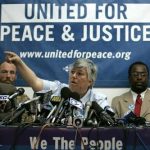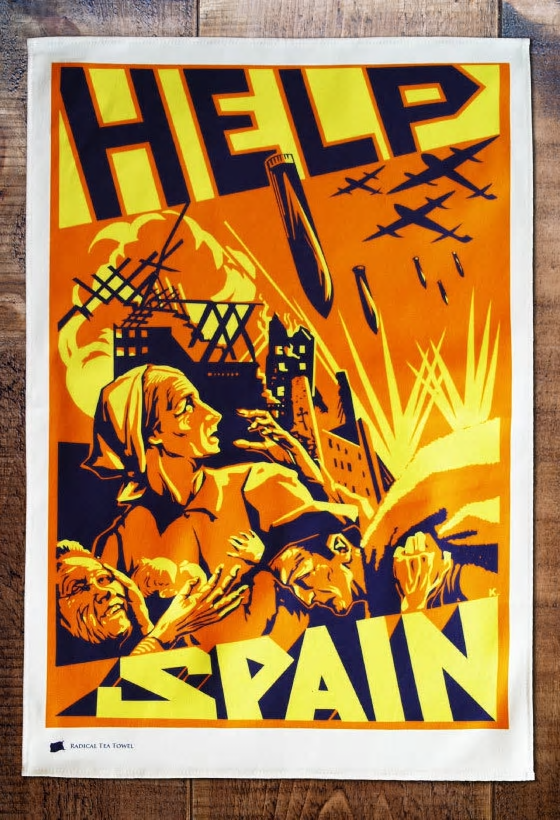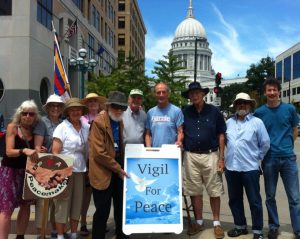Monday’s Noon-1pm Corner MLK Jr. & Doty St. Madison City-County Bldg.
Week 1623 Date 8 April 2019
DWIGHT D. EISENHOWER, 34TH UNITED STATES PRESIDENT AND GENERAL:
(October 14, 1890-March 18, 1969)
“During the long lane of history yet to be written, America knows that this world of ours, ever growing smaller, must avoid becoming a community of dreadful fear and hate, and be, instead, a proud confederation of mutual trust and respect. Such a confederation must be one of equals.”
(From 1961 farewell address.)
LESLIE CAGAN, UNITED FOR PEACE & JUSTICE CO-FOUNDER:
 “Now is the time for even greater activism to end the endless wars, to stop potentially catastrophic new wars, and to link the work for peace to the movements for special, economic and climate justice. ”
“Now is the time for even greater activism to end the endless wars, to stop potentially catastrophic new wars, and to link the work for peace to the movements for special, economic and climate justice. ”
(b. 1947- )
SMEDLEY D. BUTLER, RETIRED UNITED STATES MARINE CORPS MAJOR GENERAL AND TWO-TIME MEDAL OF HONOR RECIPIENT:
(July 30, 1881-June 21, 1940)
“In his book, “WAR IS A RACKET” Smedley Butler points to a variety of examples, mostly from World War I, where industrialists, whose operations were subsidized by public funding, were to generate substantial profits, making money from mass human suffering.”
War is a Racket – Online Book by Smedley Butler
We are moved to say that not only is it not enough to say, “War is a Racket,” which this writer greatly respects Butler for saying, but it’s what we do that counts as well. The saying and the doing are two quite different things which brings us to next week’s Vigil for Peace.
With 57 percent of the Trump $1.3 trillion discretionary budget going to the Pentagon and nuclear weapons enhancement, we are calling attention to those ways in which our tax dollars are spent. Join us next Monday at Noon in calling for an end to paying for our country’s numerous undeclared wars and all matter of violence leading to war. Take for example the F-35A.
Butler wrote this:
“War is a racket. It always has been. It is possible the oldest, easily the most profitable, surely the most vicious. It is the only one international in scope. It is the only one in which the profits are reckoned in dollars and the losses in lives. A racket is best described, I believe, as something that is not what it seems to the majority of the people. Only a small ‘inside’ group knows what it is about. It is conducted for the benefit of the very few, at the expense of the very many. Out of war a few people make huge fortunes.”

JOIN US FOR TAX DAY–MONDAY, APRIL 15, 2019
5 Billion Dollars on F-35A planes OR Human Needs & the Environment?
DOLLARS THAT HIT HOME IN OUR OWN BACK YARD:
Currently each F-35A plane costs $110 million to manufacture. The F-35A costs approximately $42,000 per hour to fly. Assuming a plane flies 120 hours a year, over 20 years, that comes to $100 million.
The F-35 Is About to Get A Lot Cheaper. Sort Of.
24 x F-35A Fighter planes (@ $210 million each) = approximately 5 billion dollars.
Here are nine things we could buy for $5 billion instead:
1. Provide Medicaid for 1.4 million people. At the program’s current costs, $5 billion could provide Medicaid – cost-effective, quality insurance – for 1.4 million Americans.
2. Triple federal spending on energy The United States budget for energy efficiency and renewable energy is $2 billion. Adding $5 billion would triple the budget.
3. Give the Environmental Protection Agency a 60% Raise This federal defender for clean water, clean air, protection of endangered species, safe disposal of toxic waste, land conservation and even food quality and safety has been under assault by the current administration. A $5 billion raise would be enough to raise its budget by 60%, from $8.2 billion to $13.2 billion.
4. Increase federal aid to public K-12 schools by 30% The primary source of federal aid to public schools is the Title I program that provides federal funding to schools that serve lower income students. More than half of all public schools in the United States benefit from the program. In 2017, Title I grants to public schools totaled $14.9 billion. An additional $5 billion would be a 30% increase to this aid.
6. Double heating assistance for low-income households The Low Income Home Energy Assistance program provides support to low-income households to help them afford heating and cooling costs. Its 2017 budget was just short of $3.4 billion, so a $5 billion increase could more than double it.
8. Double funding for substance abuse and mental health
Yet the current budget for the main federal agency that handles both substance abuse and mental health, the Substance Abuse and Mental Health Services Administration (SAMHSA), received just $4.1 billion in federal funds in 2017. Adding $5 billion to that could more than double current funding.
Nine Things to Buy with $5 Billion Instead of a Border Wall from National Priorities Project
The group meets in downtown Madison from 12:00 noon to 1:00 pm on the corner, by the County-City building: The corner of Martin Luther King Jr. Boulevard and Doty Street. There are signs and flyers available each week. The flyers to be handed out to passers-by.
All are welcome to join this group, which meets every Monday noon, except Federal holidays – (or if the temperature sinks below -20 degrees… and even then, some members enjoy standing for peace.)











